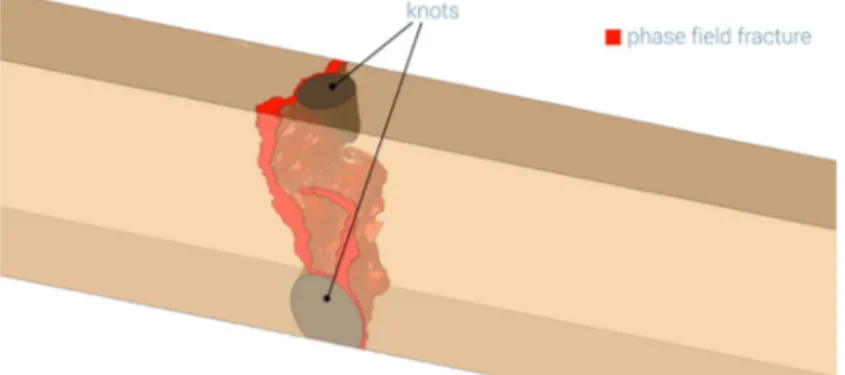ISBN: 978-91-88898-64-7
17
Phase field method-based modeling of fracture in wood
Sebastian Pech†*, Markus Lukacevic† and Josef Füssl†
†Vienna University of Technology, sebastian.pech@tuwien.ac.at; markus.lukacevic@tuwien.ac.at; josef.fuessl@tuwien.ac.at
Wood, as a naturally grown material, exhibits an inhomogeneous material structure as well as a quite complex material behavior. For these reasons, the mechanical modelling of fracture processes in wood is a challenging task and requires a careful selection of numerical methods. Promising approaches like limit analysis [1] or the extended finite element method (XFEM) in combination with microstructure materials models [2] deliver good but not yet satisfying results. Particularly the latter approach, including XFEM, has severe difficulties with crack paths in regions with complex morphology, mainly around knots. Therefore, in this work, focus is laid on the recently emerging and very popular phase field method [3]. Especially geometric compatibility issues that limit the use of XFEM can be avoided, as the crack is not discretely modeled but smeared over multiple elements. This allows the formation of complex crack patterns, defined by the underlying differential equations and boundary conditions but not restricted by the mesh geometry.
The present implementation contains a micro-mechanical model-based tsai-wu failure criterion [2] and allows considering orthotropic material behavior through a structural tensor which scales the phase field’s length scale parameter [4]. For solving the system of differential equations, a staggered approach is used where the phase field equation and deformation problem are solved separately. The staggered approach is enhanced with an additional Newton-Raphson loop that ensures convergence [5].
The developed algorithm was tested on various problems. Compared to XFEM more computation time was needed as the phase field method requires a finer discretization. However, crack patterns, including branching and merging, could be modeled very stable and accurately, even in the vicinity of knots where the material structure of wood is particularly complex and interface zones exist (see Figure 1).
Figure 1: Cracking between two knots under uniaxial tension modeled with phase field approach
References
[1] Li, M., Füssl, J., Lukacevic, M., Eberhardsteiner, J., & Martin, C. (2018). Strength predictions of clear wood at multiple scales using numerical limit analysis approaches. Computers & Structures, 196, 200–216.
[2] Lukacevic, M., Lederer, W., & Füssl, Josef (2017). A microstructure-based multisurface failure criterion for the description of brittle and ductile failure mechanisms of clear-wood. Engineering Fracture Mechanics, 176, 83–99. [3] Miehe, C., Schänzel, L., & Ulmer, H. (2015). Phase field modeling of fracture in multi-physics problems. part i.
balance of crack surface and failure criteria for brittle crack propagation in thermo-elastic solids. Computer Methods in Applied Mechanics and Engineering, 294, 449–485.
[4] Teichtmeister, S., Kienle, D., Aldakheel, F., & Keip, M. (2017). Phase field modeling of fracture in anisotropic brittle solids. International Journal of Non-Linear Mechanics, 97,1–21.
[5] Seles, K., Lesicar, T., Tonkovic, Z., & Soric, J. (2019). A residual control staggered solution scheme for the phase-field modeling of brittle fracture. Engineering Fracture Mechanics, 205, 370–386.
